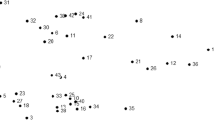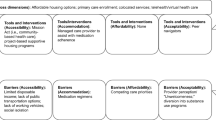Abstract
As a growing segment of the military, Native Americans are expected to increase enrollment in Department of Veterans Affairs (VA) healthcare. Currently, 20% of Native American veterans are aged 65–74, which means they served during the Vietnam era. This study explores the experiences of rural American Indian veterans from two Montana reservations with accessing VA health services. Utilizing detailed data obtained in focus group and individual interviews, we examine the experiences, attitudes, barriers and needs of rural Vietnam-era veterans. Analyses indicate that while Native American Vietnam-era veterans experienced a poor reception returning to the US after military service, they had more positive receptions in their home reservation communities. However, reintegration was often impeded by poor local opportunity structures and limited resources. As they have aged and turned to the VA for healthcare, these veterans have encountered barriers such as lack of information regarding eligibility and services, qualifying for care, excessive distances to health services, the cost of travel, and poor quality of assistance from VA personnel. Despite variations in their resources, tribal community efforts to honor veterans have begun to facilitate better access to healthcare. Focusing on the roles and importance of place–based resources, this study clarifies challenges and obstacles that Native American Vietnam-era veterans experience with accessing VA health services in rural, reservation communities. Additionally, findings show how tribal efforts are facilitating access as they begin to implement the 2010 agreement between the VA and Indian Health Services to better serve Native veterans.
Similar content being viewed by others
References
U.S. Department of Veterans Affairs. American Indian and Alaska native service members and veterans. 2012b. Available at: http://www.va.gov/TRIBALGOVERNMENT/docs/AIAN_Report_FINAL_v2_7.pdf. Accessed October 12, 2013.
Mulhall, E. (2009) Women warriors: Supporting she “who has borne the battle.” New York: Iraq and Afghanistan veterans of America. Available at: http://media.iava.org/IAVA_WomensReport_2009.pdf. Accessed May 10, 2013.
U.S. Department of Veterans Affairs, American Indian and Alaska native veterans: 2013 American community survey. 2015B. Available at: http://www.va.gov/vetdata/docs/SpecialReports/AIANReport2015.pdf. Accessed January 23, 2016.
U. S. Department of Veterans Affairs Health benefits: Veterans eligibility. 2014. Available at: http://www.va.gov/healthbenefits/apply/veterans.asp. Accessed October 12, 2013.
United States Census Bureau. Quick facts Montana. 2015. Available at: http://www.census.gov/quickfacts/table/PST045215/30. Accessed January 2016.
Sanders, S., Erickson, L., Call, V., McKnight, M., & Hedges, D. (2015). Rural health care bypass behavior: How community and spatial characteristics affect primary health care selection. The Journal of Rural Health, 31(2), 146–156.
CMS Alliance to Modernize Healthcare (CAMH). (2015). Independent Assessment of the Health Care Delivery Systems and Management Processes of the Department of Veterans Affairs, Volume I: Integrated Report. Bedford, MA and McLean VA: Mitre Corporation.
Spoont, M., Greer, N., Su, J., Fitzgerald, P., Rutks, I., Wilt, T. (2011) Rural vs. urban ambulatory health care: a systematic review. Department of Veterans Affairs Health Services Research & Development Service. VA-ESP Project #09–009.
Kramer, B. J., Jouldjian, S., Washington, D. L., Harker, J. O., Saliba, D., & Yano, E. M. (2009). Health care for American Indian and Alaska native women: The roles of the Veterans Health Administration and the Indian Health Service. Women’s Health Issues, 19, 135–143.
Kaufman, C. E., Brooks, E., Kaufmann, L. J., et al. (2013). Rural native veterans in the veterans health administration: Characteristics and service utilization patterns. The Journal of Rural Health: Official Journal of the American Rural Health Association and the National Rural Health Care Association, 29, 304–310.
Atkinson, S., Fuller, S., & Painter, J. (2012). Wellbeing and Place. Surrey. England: Ashgate Publishing, Ltd.
Macintyre, S., & Ellaway, A. (2000). Ecological approaches: Rediscovering the role of the physical and social environment. In L. Berkman & I. Kawachi (Eds.), Social epidemiology (pp. 332–348). Oxford: Oxford University Press.
Macintyre, S., Maciver, S., & Sooman, A. (1993). Area, class and health: Should we be focusing on places or people? Journal of Social Policy, 22, 213–234.
Rollero, C., & De Piccoli, N. (2010). Place attachment, identification and environment perception: An empirical study. Journal of Environmental Psychology, 30, 198–205.
Sampson, R., & Groves, W. (1989). Community structure and crime: Testing social disorganization theory. American Journal of Sociology, 94, 774–802.
McMillan, D. W. (1996). Sense of community. Journal of community psychology, 24(4), 315–325.
Wen, M., Hawkley, L. C., & Cacioppo, J. T. (2006). Objective and perceived neighborhood environment, individual SES and psychosocial factors, and self-rated health: An analysis of older adults in Cook County, Illinois. Social Science and Medicine, 63(10), 2575–2590.
Bitsol, A. L. (2013) Vietnam vets still have complaints. Navajo Times. Available at: http://navajotimes.com/news/2013/0413/040413vie.php. Accessed March 6, 2016.
Azure, B. L. (2011) In the company of heroes: CSKT honors and recognizes their Vietnam veterans. Char-Koosta News. Available at: http://www.charkoosta.com/2011/2011_11_17/In_the_company_of_heroes.html. Accessed March 6, 2016.
Biskupic, J. M. (1984) Indian vets got something special: a warm welcome home from Vietnam. News OK: The Oklahoman. Available at: http://newsok.com/article/2077156. Accessed March 6, 2016.
Erickson, L. D., Yorgason, J. B., & Call V. R. A. (2015) Help-seeking Behavior Among Veterans and Non-Veterans in Rural Utah. Journal of Rural Community Psychology. E15, 1.
Erickson, L. D., Hedges, D. W., Call V. R. A., & Bair, B. (2013). Prevalence of and factors associated with subclinical posttraumatic-stress symptoms and PTSD in urban and rural areas of Montana: A cross-sectional study. The Journal of Rural Health: Official Journal of the American Rural Health Association and the National Rural Health Care Association, 29(4), 403–412.
Sanders, G. F., Fitzgerald, M. A., & Bratteli, M. (2008). Mental health services for older adults in rural areas: An ecological systems approach. Journal of Applied Gerontology, 27(3), 256–266.
Xue, C., Ge, Y., Tang, B., et al. (2015). A meta-analysis of risk factors for combat-related PTSD among military personnel and veterans. PLoS ONE, 10(3), 1–21.
Berg, B. (2008) In: Bacon Allyn (Ed.), Qualitative Research Methods. Boston, MA.
Ward, C., Solomon, Y., Stearmer, S. M. (2011). Access to health care in rural communities and highly rural areas: Views of veterans, community members and leaders and service providers. White Paper submitted to Department of Veterans Affairs, Office of Rural Health, Veterans Rural Health Resource Center, Western Region, Salt Lake City, Utah.
Watson, E. (2014). Montana economic at a glance: Montana reservation labor markets. Helena, MT: Montana Department of Labor & Industry, Research and Analysis Bureau.
U.S. Department of Veterans Affairs, 2012. American Indian and Alaska native service members and veterans. Available at: http://www.va.gov/TRIBALGOVERNMENT/docs/AIAN_Report_FINAL_v2_7.pdf. Accessed October 12, 2013.
Funding
This research was supported in part by the College of Family Home and Social Sciences, Brigham Young University, Provo, Utah.
Author information
Authors and Affiliations
Corresponding author
Ethics declarations
Conflict of interest
The authors declare that they have no conflict of interest.
Rights and permissions
About this article
Cite this article
Ward, C.J., Cope, M.R. & Elmont, L. Native American Vietnam-era Veterans’ Access to VA Healthcare: Vulnerability and Resilience in Two Montana Reservation Communities. J Community Health 42, 887–893 (2017). https://doi.org/10.1007/s10900-017-0330-y
Published:
Issue Date:
DOI: https://doi.org/10.1007/s10900-017-0330-y




